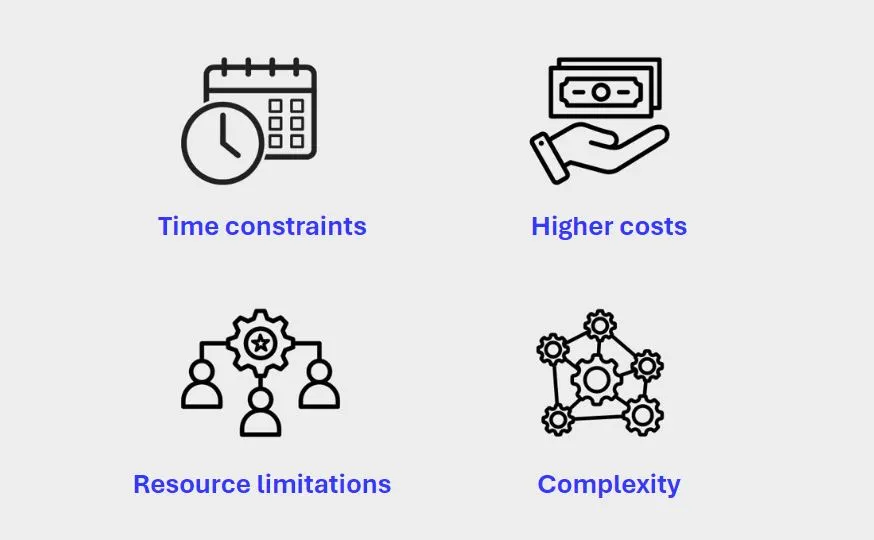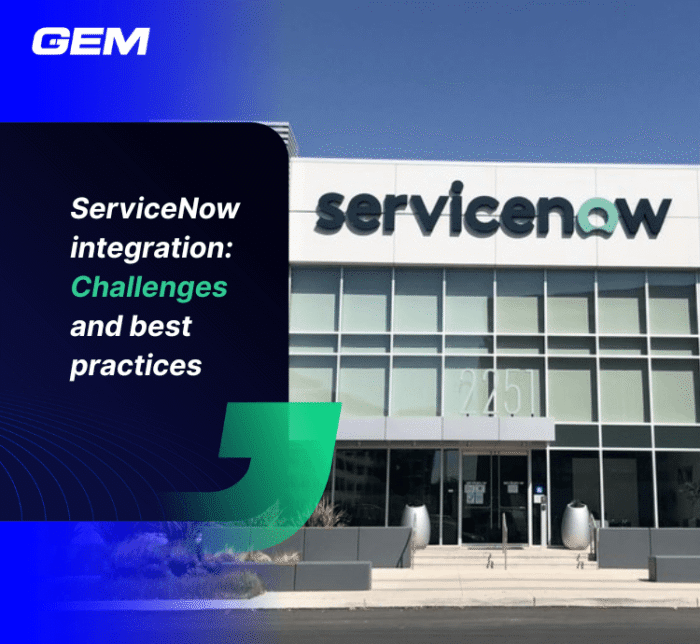Contents
- Overview of no code and low code development platforms
- How digital transformation is driven by low code and no code development
- No-code and low code development platforms – Challenges and considerations
- Low code and no code in driving digital transformation – What the future holds
- Closing remark
- Step into a new chapter of digitally driven success
In today’s fast-paced business environment, digital transformation is a necessity.
No code and low code development platforms offer revolutionary solutions to these challenges. They help businesses develop applications with minimal coding by leveraging visual development environments and pre-built modules.
According to Gartner, by 2025, 70% of new applications enterprises develop will use no-code or low-code technologies, a significant increase from less than 25% in 2020. This dramatic rise highlights the growing recognition of the value and potential of these platforms in driving digital transformation.

Overview of no code and low code development platforms
These platforms provide a user-friendly, visual development environment that allows users to create applications with minimal coding effort. By leveraging drag-and-drop interfaces, pre-built templates, and reusable components, businesses can rapidly develop and deploy applications without the need for extensive programming knowledge.
This democratization of application development empowers a broader range of employees, enabling quicker iterations and fostering innovation across the organization.
Current development strategies have their shortcomings that make it hard for firms to adjust to the dynamic business environment. That is what creates an urgent need for the widespread use of no code and low code development platforms.
The current business landscape
The necessity for digital transformation is driven by several significant trends reshaping the business environment.

Increasing customer demands
Customers today demand seamless, personalized experiences across all digital touchpoints. Businesses must continuously innovate to meet these expectations and stay ahead of competitors.
The rising number of digital-first competitors
New entrants in various industries are often digital-first companies, leveraging the latest technologies to disrupt traditional business models. Established companies need to adapt quickly to maintain their market position.
The pressing need for operational efficiency
Due to tight budgets and economic uncertainty, organizations are pressured to streamline operations, reduce costs, and improve efficiency. Digital solutions are essential to achieving these goals.
Shortcomings of traditional software development methods
Compared to low code and no code application development, traditional methods may fail to address the demands of the modern business environment.

Time constraints
Developing custom applications from scratch is a time-consuming process. Lengthy development cycles can delay product launches and hinder the ability to respond to market changes swiftly.
Higher costs
Custom software development requires significant financial investment in skilled developers, infrastructure, and ongoing maintenance. These high costs can be prohibitive, especially for small and medium-sized enterprises.
Resource limitations
The scarcity of skilled developers is a major bottleneck. Many organizations struggle to recruit and retain the necessary talent to support their digital initiatives. Meanwhile, this challenge can easily be solved with no code and low code development platforms
Complexity
Traditional development projects often involve complex requirements and dependencies, increasing the risk of delays and project failures.
Low-code and no-code development platforms address these challenges by offering a faster, more cost-effective, and accessible approach to application development. By streamlining the development process and reducing reliance on specialized skills, these platforms enable businesses to accelerate their digital transformation efforts and achieve their strategic objectives.
How digital transformation is driven by low code and no code development
Low-code and no-code platforms offer numerous advantages that address common challenges faced in traditional development. Therefore, they accelerate and enable digital transformation.

Promoting speed and agility
No code and low code development platforms enable businesses to develop and deploy applications rapidly.
Traditional development methods involve lengthy processes, but LC/NC platforms streamline these processes with visual development environments, pre-built templates, and drag-and-drop functionalities.
This allows businesses to quickly prototype, test, and deploy applications, reducing time-to-market and enabling swift responses to changing market demands. The reduction can be as dramatic as from several months to only a few weeks.
Cost-effectiveness
Low code and no code application development is cost-effective because it significantly reduces the need for extensive development teams and minimizes development costs.
A 2021 report revealed that low-code tools can help the average company save $4.4 million over three years.
Enhancing accessibility and collaboration
Low code and no code application development allows non-technical users to create applications, fostering collaboration between IT and business units. This inclusivity ensures that applications better meet the needs of end-users and enhance cross-departmental collaboration.
A 2018 survey by Mendix, a leading low-code platform vendor, found that 25% of their developer community had no coding experience, and 40% came from a business background. This shows how easy the platform is for non-technical users and how it helps them get involved in development, bringing technical and business teams closer together.

Accelerating innovation
No code and low code development platforms foster a culture of innovation by simplifying the process of experimenting with new ideas and features. They enable rapid iteration and prototyping, thus promoting continuous improvement and adaptability, which are crucial for maintaining a competitive edge.
Enabling easier maintenance and updates
Leveraging low code and no code application development makes maintenance and updates easier due to several factors.
First, these platforms often come with built-in version control and update management tools, which streamline the process of applying updates and patches.
Second, the visual development environment and modular architecture allow for easier identification and modification of specific components without disrupting the entire application.
Additionally, the reusable components and pre-built modules provided by low code and no code application development ensure consistency and reduce the complexity of making changes, leading to fewer errors and quicker deployment of updates.

No-code and low code development platforms – Challenges and considerations
While low code and no code application development offers significant advantages, businesses must also navigate certain challenges and considerations to maximize their benefits.
Security concerns
One of the primary concerns associated with no code and low code development platforms is security.
Since they are designed to be accessible to non-technical users, there is a potential risk of creating applications that may not adhere to recommended security practices. Additionally, the ease of deploying applications quickly can sometimes lead to insufficient testing and oversight, increasing vulnerability to cyber threats.
To mitigate these risks, businesses should implement comprehensive security protocols such as:
- Regular security audits
- Automated testing
- Adherence to secure coding standards
It is also crucial to ensure that the platform provider adheres to robust security measures and complies with industry standards and regulations.

Customization limits
While no code and low code app development is fast, it can sometimes fall short when it comes to highly customized or complex requirements. This is because predefined templates and components may not always provide the level of flexibility needed for certain applications.
To manage these limitations, businesses should conduct a thorough assessment of their requirements. In cases where extensive customization is necessary, it might be beneficial to adopt a hybrid approach, combining low-code/no-code solutions with traditional development to leverage the strengths of both methodologies.
Additionally, selecting a platform that offers a high degree of extensibility and integration capabilities can help bridge the gap between out-of-the-box functionality and custom needs.
Difficulty in integrating with existing systems
Ensuring seamless integration of no code and low code development platforms with existing IT infrastructure is also a significant challenge.
To address this, businesses should choose a platform that supports robust integration capabilities, such as APIs, webhooks, and connectors. Thorough planning and testing should be conducted to ensure compatibility and smooth data flow between systems.
Additionally, involving IT professionals in the integration process can help identify potential issues early and develop strategies to overcome them, ensuring a seamless and efficient integration.

Low code and no code in driving digital transformation – What the future holds
In this section, we explore the future landscape of low-code and no-code platforms, focusing on the emerging trends and advancements that are set to shape their impact on digital transformation.
Future tech trends
As low-code and no-code platforms continue to evolve, several emerging trends and advancements are poised to shape their future impact on digital transformation.
Increased integration of AI and ML
One significant trend is the integration of AI and machine learning capabilities into no code and low code development platforms. This development will enable users to create more intelligent and adaptive applications with minimal effort.
AI-driven features, such as predictive analytics, natural language processing, and automated decision-making, will become more accessible and allow businesses to harness the power of advanced technologies without the need for specialized expertise.
More collaboration tools
Future low code and no code application development is likely to incorporate more robust collaboration tools to facilitate teamwork across different departments. Features such as real-time editing, version control, and integrated communication channels will enable seamless collaboration between technical and non-technical users, enhancing productivity and innovation.
Expansion of industry-specific solutions
LC/NC platforms are expected to expand their offerings with more industry-specific solutions. These tailored solutions will address the unique challenges and requirements of various sectors, such as healthcare, finance, manufacturing, and retail, providing businesses with ready-to-use templates and components designed for their specific needs.
Improved governance and compliance
As the adoption of no code and low code development platforms grows, there will be a greater emphasis on governance and compliance features. Enhanced auditing, role-based access control, and compliance management tools will ensure that applications built on these platforms adhere to regulatory standards and organizational policies.

Evolving business models
The widespread adoption of low code and no code development is set to influence future business models and strategies in several profound ways.
Democratization of innovation
These platforms empower employees at all levels of an organization to contribute to the innovation process.
By reducing the dependency on specialized IT teams, they democratize application development, enabling a broader range of employees to create solutions that drive business growth. This shift fosters a culture of continuous improvement and innovation, as more individuals can experiment with and implement new ideas.
Accelerated time-to-market
Businesses leveraging low code and no code platforms can bring new products and services to market faster than ever before.
The ability to rapidly develop and deploy applications allows companies to respond swiftly to changing market conditions and customer demands. This agility provides a competitive advantage, enabling businesses to capitalize on new opportunities and stay ahead of competitors.

Stronger focus on core competencies
By automating and streamlining the application development process, no code and low code development platforms enable businesses to focus more on their core competencies. Companies can allocate resources and attention to strategic activities that differentiate them in the market, rather than being bogged down by lengthy and complex development projects.
Closing remark
Low-code and no-code development platforms are accelerating businesses’ speed of realizing their digital initiatives by enabling more rapid development, reducing costs, enhancing collaboration, and fostering innovation. Therefore, they open up new opportunities for raising revenue and enhancing their competitive relevance.
Step into a new chapter of digitally driven success
Are you ready to accelerate your digital transformation journey? Partner with GEM Corporation, the award-winning IT outsourcing company renowned for delivering excellence. With over 100 successful projects for prestigious clients worldwide and ISO-certified delivery processes, our track record speaks for itself!
Take the first step towards innovation and operational excellence via the form below.






